Developing A T-Shaped Skillbuilding Plan
Skillbuilding is an important part of your marketing career at any level.
If you’re a marketing student, getting a quick grasp of the basics and the landscape should be your priority.
If you’re a marketing associate, then diving deep into core channel skills and developing a specialty should be your M.O. Understanding the basics of complimentary channels would also be a good idea.
As a marketing manager, the skills you need are more about people, process, budgets, and vendors, but you still need to know how your channels are evolving today and in the future.
And as a marketing executive, the skills you should be building are around fostering collaboration, creating marketing team culture, leading change, and optimizing team costs and performance.
The T-Shaped Marketer is a core concept at TheMarketingHelp. Originally coined by McKinsey & Company as they recruited consultants who had “broad base knowledge and deep skillsets related to their specialty,” it has since been adopted by many disciplines, in particular Software Development and Marketing.
For Marketers, the ‘T’ shape takes form by layering the shared skills across the team on top of the Core skills to the Marketer’s role, and adding in complementary skills related to the Core.
Each and every marketing role has its own ‘T’ made up of a horizontal ‘Team-Wide’ skill stack, and a vertical ‘Core Role’ skill stack. As the Marketer gains Team-Wide skills, their ‘T’ grows horizontally; as they gain Core skills, the ‘T’ grows vertically; as they gain Support skills, the vertical part of the ‘T’ fattens.
To become a T-Shaped Marketer, you need to
Assess your current skills and gaps
Set a Skillbuilding goal (pulled from your Career Strategy)
Make a Skillbuilding Plan to address the gaps
Assess Your Current Marketing Skills
The best way to assess your current marketing skills is by completing your Career Profile. This is the second step in designing a Marketing Career Strategy, and it part inventory, part self-discovery. Learn more about the Career Profile in one of our recent podcasts:
Set A Skillbuilding Goal
Next, set a big goal for yourself. We’re not talking about a small, short-term goal, like “I want to get certified in Google Analytics” - that’s too narrow. Your goal should be big, audacious, and map directly back into your Career Strategy.
Strong goals for skillbuilding might be…
“I’m going to level-up my skills to get promoted in my current role”
“I’m going to gain new skills so I can transition from a Traditional Marketing to a Digital Marketing role within the company”
“I’m going to become a more desirable candidate and find a bigger role at a new company.”
These are goals that take into account your Career Factors and are in line with your desired Career Path.
Make A Skillbuilding Plan
Next, it’s time to create your Skillbuilding Plan. Ideally, your plan will be made up of:
Skill Gaps
Skill Objectives
Skill Validations
For your marketing skill gaps, what skills will you absolutely need in order to achieve your career goal? Which of those marketing skills do you have, and which do you not yet have?
Now prioritize them. Which are truly critical for you to take the next step toward your career goal, and which are the nice-to-have differentiators? Can some be achieved quickly, like mastering the basics of Google Analytics, or will they take some time, like becoming proficient at Inbound Marketing?
If achieving your goal is urgent (<6 months), then you’ll need to be ruthless with your prioritization because you only have so much time each week and each month to dedicate to skillbuilding.
If achieving your goal is less urgent (>6 months), then your skill gap list to conquer can be more extensive, and you can take a more long-term approach.
Next, take your critical skill gaps, and give yourself a time constraint.
As a guide, use our 3&3 approach, and try to build skills either in 3 weeks or in 3 months.
Last, does the skill have a widely recognized certification? For marketing analytics, this might be a Google Analytics Certification. For inbound marketing, this might be HubSpot Certification. For marketing creative, this might be a Canva design course.
If you can gain the skill, and have an external validation to reference on your resume, portfolio, and LinkedIn profile, then you’ll have an easier time conveying the skill to others who may hold the keys to your skillbuilding goal (like a promotion or new role).
Track Your Skillbuilding Progress
As with any career goal, holding yourself accountable is paramount in skillbuilding for Marketers.
Use our 3&3 Skillbuilding Tracker to slot in your skill gaps into either the 3-Week column or 3-Month column. This will give you a clear bird’s eye view at your current skill gaps, what to do right now, and what to do next.
Be sure to set up recurring reminder events on your calendar for each week for the next three months for added motivation (and accountability).
In our 3&3 Skillbuilding Tracker, we also include a reminder event template that you can use to get started even faster toward your skillbuilding goal.
And if you really want to take your skillbuilding accountability to the next level, find a skillbuilding partner - a fellow marketer who can go on a 3&3 journey with you.
Check in together over coffee each week, ask each other what you’re reading, what podcasts you’re listening to, what certifications you’re taking, and what else you’re doing to level up.
You’ll find that, not only will you gain those skills faster, but by sharing in your colleague’s, classmate’s, or professional connection’s progress, you’ll have more fun skillbuilding yourself.
Interested in learning more about Skillbuilding Plans? Listen to our recent podcast episode:

